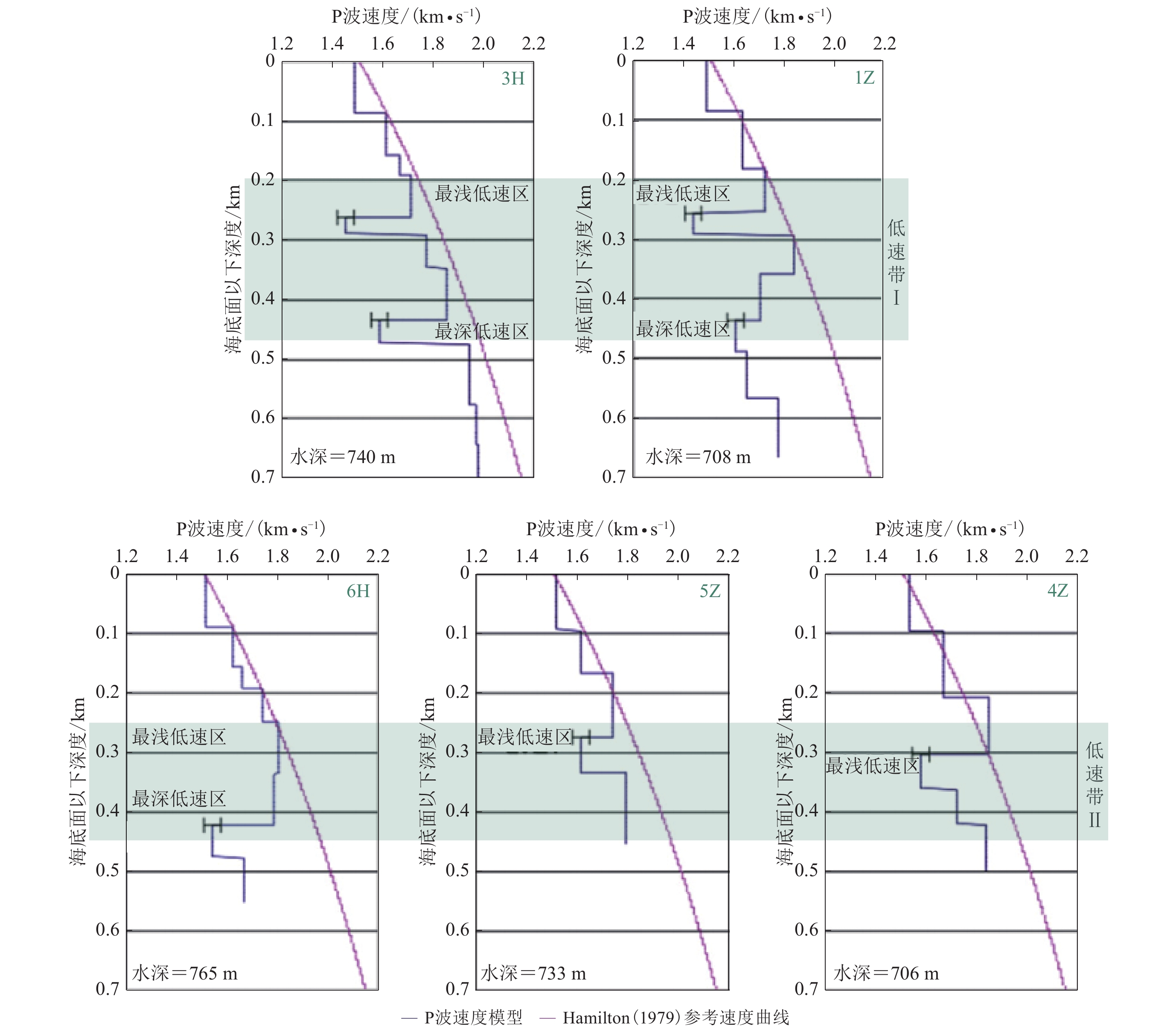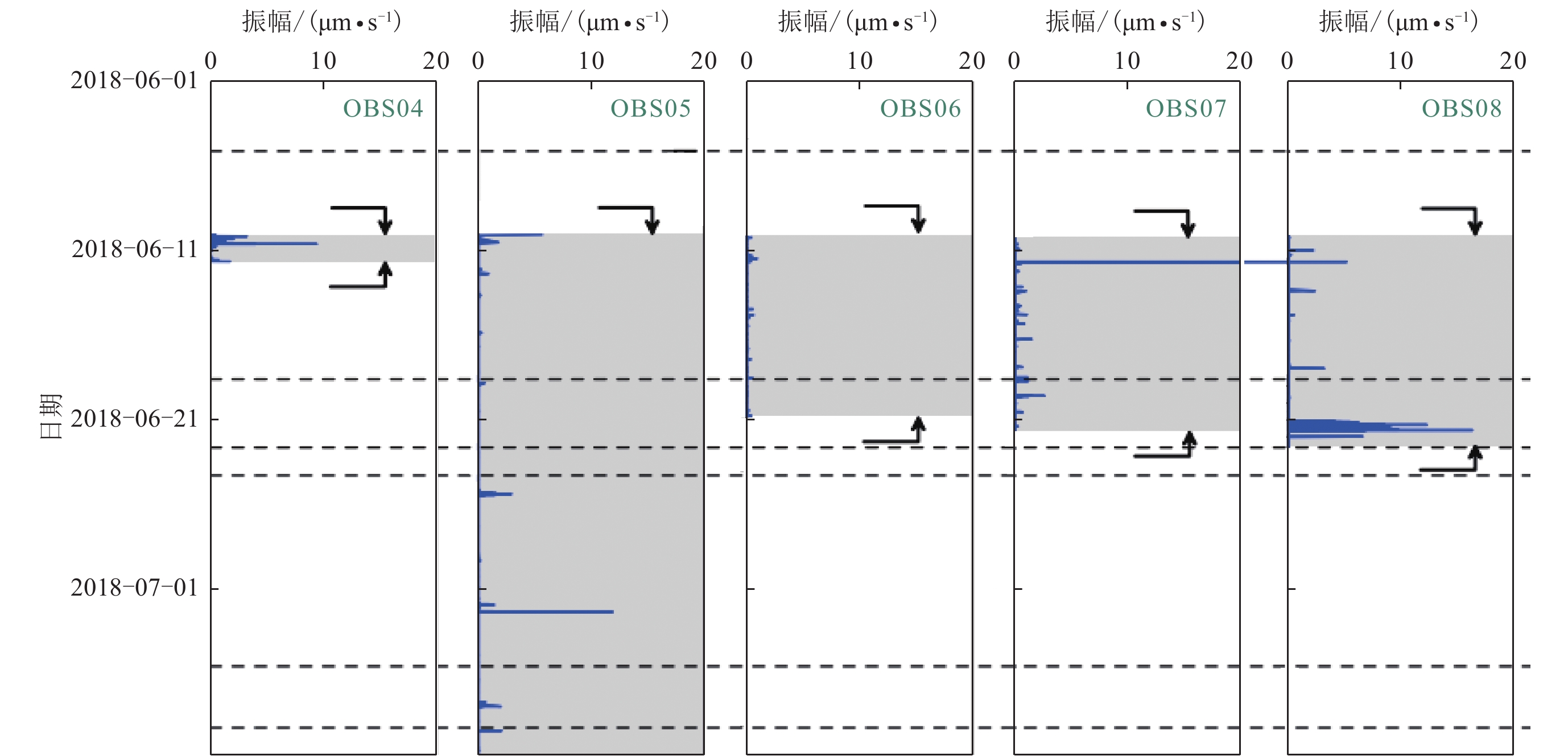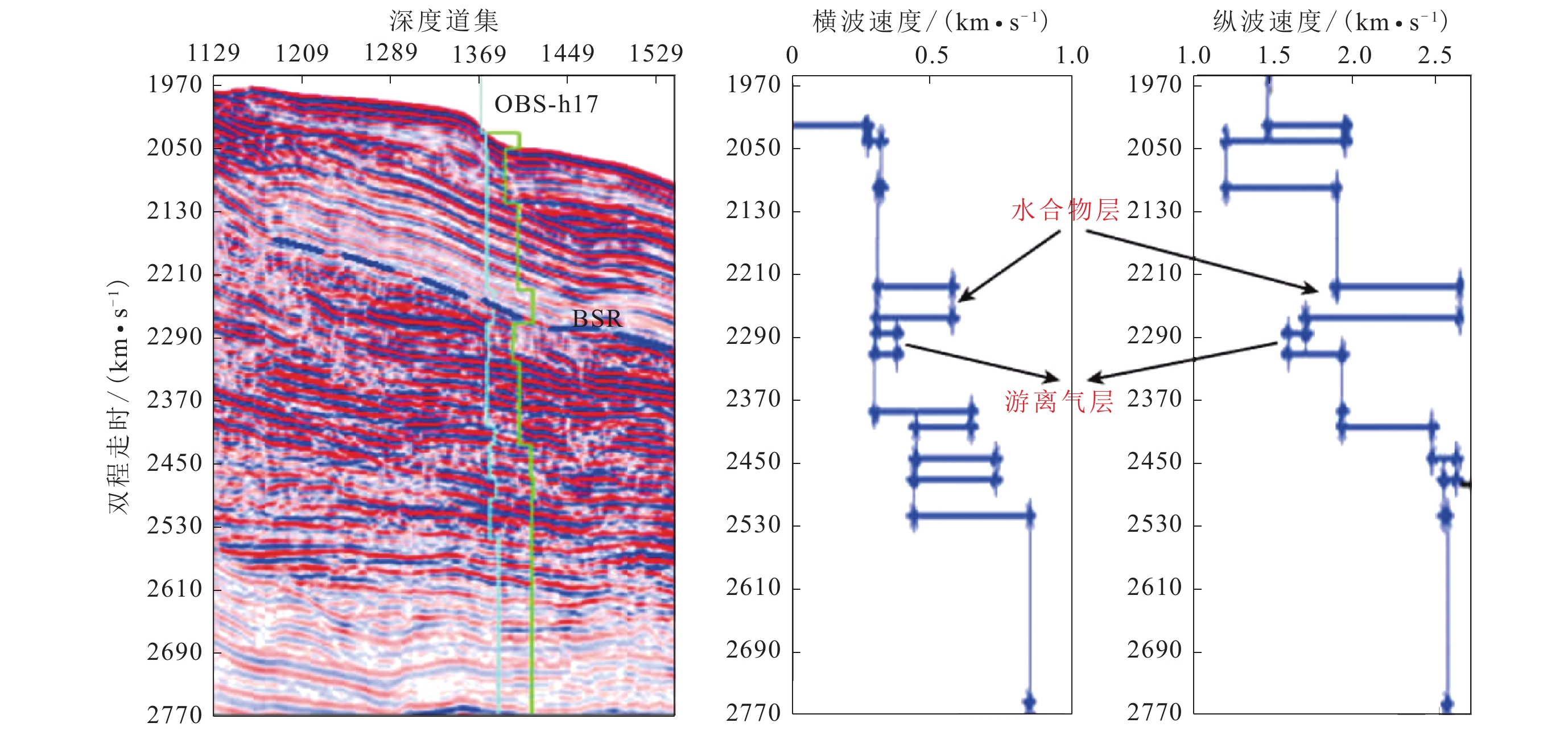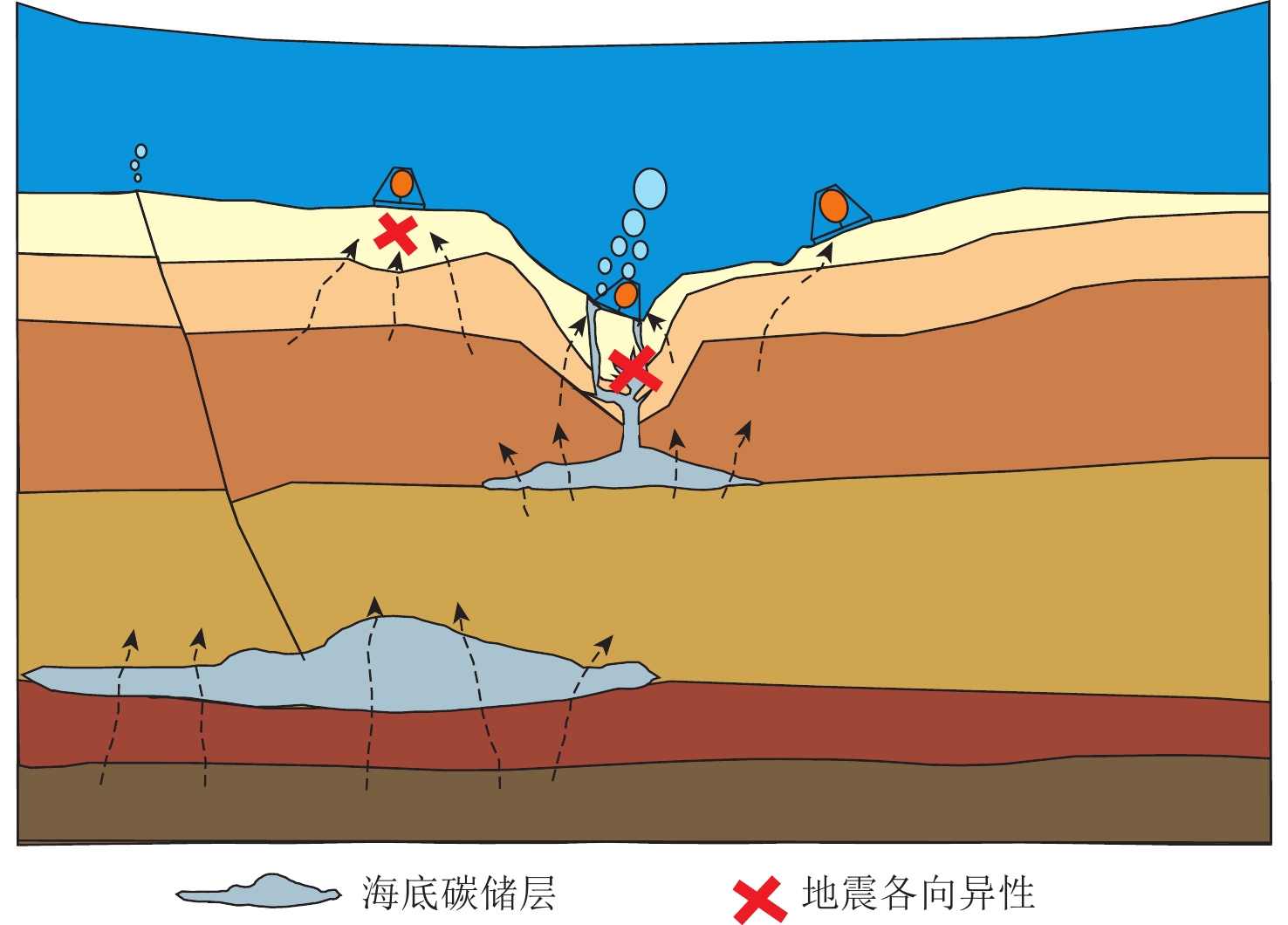Research progress on detection of carbon leakage by ocean bottom seismometer
-
摘要: 海底碳封存是解决全球温室效应,提高碳汇的重要手段. 然而,海底碳封存会存在碳泄漏的风险,因此有必要对碳储层结构和海底碳泄漏进行监测. 其中,一种有效的监测手段是海底地震仪(OBS)多波多分量地震探测. 本文介绍了使用OBS探测技术对储层结构和海底地壳内流体的探测实例:主要包括二维、三维台阵OBS试验,使用的方法为走时反演、各向异性分析以及微地震方法. 使用OBS进行多波多分量地震探测有范围广、深度大、信噪比高、大偏移距的优点. 然而,目前二维和三维OBS探测建立的碳储层和碳泄漏模型分辨率还有待提高,可以通过使用密集台阵的方式来提高观测精度,或布设更优化的台阵来获得最佳分辨率. 随着碳中和目标的不断临近,各国碳封存的需求迫在眉睫. 因此,尽快发展OBS海底碳泄漏监测技术,保证碳封存方案的实施是尤为必要的.Abstract: Marine carbon geological storage is an important strategy to slow the global warming. However, Marine carbon geological storage may pose a risk of carbon leakage, so it is necessary to monitor the carbon storage structure and seafloor carbon leakage. One of the effective monitoring means is ocean bottom seismometers (OBS) multi-wave component seismic detection. This paper presents an example of reservoir structures and fluids within the seafloor crust using OBS detection technology. The content mainly includes two-dimensional and three-dimensional array OBS experiments, and the methods include traveltime inversion, anisotropy analysis and microseismic methods. OBS multi-component seismic detection has the advantages of wide range, large depth, high signal-to-noise ratio, and large offset. However, there is still room to improve the resolution of reservoir and leakage models established by 2D and 3D OBS inspections. The observation accuracy can be improved by using a dense array, or a more reasonable array method can be used to obtain the best resolution. As the goal of carbon neutrality draws nearer, the need for carbon sequestration in countries is imminent. Therefore, it is particularly necessary to develop OBS seabed carbon leakage monitoring technology as soon as possible to ensure the implementation of carbon sequestration programs.
-
-
图 4 斯瓦尔巴特群岛西部陆缘天然气水合物探测主要结果
(a) N3目标区P波和S波二维速度结构剖面;(b−f) N1,N2,N3,S1及S2目标区的P波和S波一维速度结构(Chabert et al,2011)
Figure 4. Main results of natural gas hydrate detection in the western Marginal area of the Svalbard Islands
(a) Two-dimensional velocity structure profiles of P-wave and S-wave in N3 target area;(b−f) One-dimensional velocity structures of P-wave and S-wave in N1,N2,N3,S1 and S2 target areas (Chabert et al, 2011)
图 1 墨西哥湾Holstein油田开发延时地震监测应用
(a) 2001年首次地震探测获得的含油气储层地震振幅切片,图中白线为起始的油水接触界面,红色区域为含油区,蓝色区域为 含水区;(b) 2006年第二次地震探测获得的含油气储层地震振幅切片,橙色线为新的油水接触界面(van Gestel et al,2008)。
Figure 1. Real-time delay seismic monitoring of Holstein oil field development in the Gulf of Mexico
(a) Seismic amplitude slice of oil and gas reservoir obtained by the first seismic detection in 2001,the white line in the figure is the initial oil-water contact interface,the red area is the oil-bearing area,and the blue area is the water-bearing area;(b) Seismic amplitude slice of oil and gas reservoir obtained by the second seismic detection in 2006,the orange line is the new oil-water contact interface (van Gestel et al,2008)
图 2 挪威北海Valhall油田永久式海底电缆长期观测结果
(a) Valhall油田海底电缆分布示意及LoFS1与LoFS6,LoFS8,LoFS10地震观测振幅差异;(b) 第一次观测LoFS1与LoFS2,LoFS3, LoFS4和LoFS5地震观测双程走时差异(van Gestel et al,2008)
Figure 2. Long-term observation of permanent seabed cable in Valhall oil field in the North Sea of Norway
(a) Schematic diagram of subsea cable distribution of Valhall oilfield and amplitude difference of seismic observation of LoFS1 and LoFS6,LoFS8,LoFS10;(b) Double travel time difference of seismic observation of LoFS1 and LoFS2,LoFS3,LoFS4 and LoFS5 for the first obser vation LoFS1(van Gestel et al, 2008)
图 3 在全球开展的海底碳储层及流体调查分布图
(a) 斯瓦尔巴特群岛西部陆缘麻坑构造电磁和OBS联合探测(Goswami et al,2015);(b) 挪威Nyegga麻坑构造OBS探测(Plaza-Faverola et al,2008);(c) STEMM-CCS计划,在北海分析了一个麻坑构造中独特的主动源地震各向异性(Bayrakci et al,2021);(d) 尼日尔河三角洲天然气水合物微地震探测(Sultan et al,2011);(e) 斯瓦尔巴特群岛西部陆缘天然气水合物探测(Chabert et al,2011);(f) 2009年广州海洋地质调查局南海北部陆坡天然气水合物地震调查(沙志彬等,2014)
Figure 3. A global distribution map of seabed carbon reservoir and fluid surveys
(a) Electromagnetic and OBS joint exploration of pockmark structure on the western margin of Svalbard Islands (Goswami et al, 2015);(b) OBS exploration of Nyegga pockmark structure in Norway (Plaza-Faverola et al,2008);(c) STEMM-CCS project,analyzing the unique active source seismic anisotropy in a pockmark structure in the North Sea (Bayrakci et al,2021);(d) Microseismic exploration of natural gas hydrate in Niger Delta (Sultan et al,2011);(e) Natural gas hydrate exploration on the western margin of Svalbard Islands (Chabert et al,2011);(f) Seismic survey of natural gas hydrate on the northern slope of the South China Sea by Guangzhou Marine Geological Survey Bureau in 2009 (Sha et al,2014)
图 5 挪威Nyegga麻坑五个OBS台站的P波速度模型
浅绿色区域表示低速带区域,在所有模型中都存在最浅低速区,而最深的低速区只出现在3H,1Z和6H中(Plaza-Faverola et al,2010)
Figure 5. P-wave velocity models of five OBS stations in Nyegga pockmark,Norway
The light green area indicates the low-velocity zone, All models have the shallowest low-velocity zone (LVZ1),and the deepest low-velocity zone (LVZ2) only appears in 3H,1Z and 6H (Plaza-Faverola et al,2010)
图 6 尼日尔河三角洲OBS试验中部分OBS台站记录到的脉冲信号(Sultan et al,2011)
Figure 6. Pulse signals recorded by some OBS stations during the OBS trial in the Niger River Delta (Sultan et al,2011)
图 7 斯瓦尔巴特群岛西部陆缘麻坑构造电磁和OBS联合探测
(a) OBS8下方P波速度结构,黑色实线表示OBS下方的一维P波速度,虚线表示在N3目标区的一维P波速度结构(Chabert et al,2011),绿色实线表示陆地沉积物标准P波速度结构(Goswami et al,2015);(b−c) OBS8和OBS5的地震记录,数据采用角频率分别为10,20,250和300 Hz的梯形带通滤波器进行滤波,红色圆圈为到时;(d) OBS8和OBS5的反演速度模型;(e) 地震反射数据与图(d) 叠加出的低速带
Figure 7. Electromagnetic and OBS joint exploration of pockmark structures at the western margin of Svalbard Island
(a) P-wave velocity structure below OBS8,black solid line represents the one-dimensional P-wave velocity below OBS,dashed line represents the one-dimensional P-wave velocity structure in the N3 target area by Chabert et al (2011),green solid line represents the standard P-wave velocity structure of terrestrial sediments (Goswami et al,2015);(b-c) Seismic records of OBS8 and OBS5 respectively,the data are filtered with a trapezoidal band-pass filter with angular frequencies of 10,20,250 and 300 Hz respectively,red circles indicate arrival times;(d) Inverted velocity models of OBS8 and OBS5;(e) A low velocity zone reflected by seismic reflection data superimposed on fig.(d)
图 8 欧盟STEMM-CCS在挪威北海研究甲烷储层泄漏的各向异性试验
(a) OBS1和(b) OBS8径向分量和切向分量地震记录,左图红色箭头表示径向地震图上c波相位的到达时间,红线表示由于振铃而导致的事件观测幅度最高的时间,右图中红色箭头表示在90°间隔时的极性变化;(c) Scanner麻坑水平应力分布,蓝色箭头表示区域水平应力最大值(σ1)和最小值(σ3),黄色箭头表示由高孔隙流体压力引起的局部应力条件,红色虚线表示观察到的气体的方向;(d) 麻坑下方不同界面气体聚集(红色区域)分布(Bayrakci et al,2021)
Figure 8. EU STEMM-CCS anisotropy experiment on methane reservoir leakage in the North Sea of Norway
Radial and tangential component seismic records of OBS1 (a) and OBS8 (b),the red arrow in the left figure indicate the arrival time of the c-wave phase on the radial seismic map,the red line indicates the time when the event observation amplitude is highest due to ringing,and the red arrow in the right figure indicate the polarity change at 90° intervals;(c) Scanner pockmark horizontal stress distribution map, blue arrow indicates regional maximum (σ1) and minimum (σ3) horizontal stress,yellow arrow indicates local stress conditions caused by high porosity fluid pressure,red dashed line indicates the direction of gas observed in the middle;(d) Gas accumulation distribution at different interfaces below the pockmark, indicated in red (Bayrakci et al,2021)
图 9 中国南海北部大陆坡地震反射数据及纵横波速度结构反演效果图(沙志彬等,2014)
Figure 9. Inversion effect of seismic reflection data and P-wave and S-wave velocity structure on the northern continental slope of the South China Sea (Sha et al,2014)
表 1 流体探测常用地震方法的特点
Table 1 Characteristics of commonly used seismic methods for fluid detection
研究方法 震源类型 特点和作用 二维/三维反射地震方法 人工震源 分辨率较高,探测地下结构性质和内部结构 延时地震 人工震源 评估地下流体随时间变化特征,推测流体运移特征 地震层析成像 人工震源和天然地震 分辨率较低,可确定地下构造及周边环境纵、横波速度结构 剪切波分裂 人工震源和天然地震 使用P/S转换波 地震衰减 人工震源和天然地震 地震衰减的各向异性,需使用不同频率的震源来区分地下结构的性质 微地震方法 天然地震 使用微地震作为被动震源,可以获得断裂构造的活动性和空间展布 表 2 使用OBS进行海底碳储层及泄漏探测实例
Table 2 Examples of submarine carbon reservoir and leakage detection using OBS
时间 探测区域 研究方法 来源 2008 北极地区,斯瓦尔巴特群岛
西部大陆边缘二维台阵与三维台阵结合:南部选择两个目标区分别布设四
台和三台OBS;北部则选择一条线上三个目标区,每个目标
区布设两台OBS,使用射线追踪对五个目标区进行正演模拟Plaza-Faverola等(2008) 2009 挪威中部边缘,Nyegga麻坑 布设二维台阵,两条测线分别沿线布设2台和3台OBS,
通过走时反演得到P波速度模型Chabert等(2011) 2011 尼日尔河三角洲东部边界 断层周围布设OBS以监测微地震活动性,微地震事件信号由
三分量检波器监测,水中较大振幅事件由水听器监测Sultan等(2011) 2012 中国南海北部大陆坡 使用20台OBS布设三维台阵,走时反演得到纵横波速度模型,
建立反射剖面和层位模型沙志彬等(2014) 2015 斯瓦尔巴特群岛西部
边缘Vestnesa脊布设两台OBS,使用走时反演方法得到P波速度模型 Goswami等(2015) 2021 挪威北海麻坑 布设三维台阵,横向剪切波分裂方法、地震衰减方法及微地震
方法研究麻坑构造下各向异性Bayrakci等(2021) -
拜阳,宋海斌,关永贤,陈江欣,刘伯然. 2014. 利用反射地震和多波束资料研究南海西北部麻坑的结构特征与成因[J]. 地球物理学报,57(7):2208–2222. doi: 10.6038/cjg20140716 Bai Y,Song H B,Guan Y X,Chen J X,Liu B R. 2014. Structural characteristics and genesis of pockmarks in the northwest of the South China Sea derived from reflective seismic and multibeam data[J]. Chinese Journal of Geophysics,57(7):2208–2222 (in Chinese).
郝艳军,杨顶辉. 2012. 二氧化碳地质封存问题和地震监测研究进展[J]. 地球物理学进展,27(6):2369–2383. doi: 10.6038/j.issn.1004-2903.2012.06.012 Hao Y J,Yang D H. 2012. Research progress of carbon dioxide capture and geological sequestration problem and seismic monitoring research[J]. Progress in Geophysics,27(6):2369–2383 (in Chinese).
黄绪德, 杨文霞. 2008. 转换波地震勘探[M]. 北京: 石油工业出版社: 14–45. Huang X D, Yang W X. 2008. Converted-Wave Seismic Exploration[M]. Beijing: Petroleum Industry Press: 14–45 (in Chinese).
刘斌,张衡. 2018. 海底水合物OBS数据全波形反演数值例子[J]. 地球物理学进展,33(1):379–384. doi: 10.6038/pg2018AA0580 Liu B,Zhang H. 2018. Full waveform inversion of OBS data from ocean gas hydrate:Synthetic example[J]. Progress in Geophysics,33(1):379–384 (in Chinese).
刘保金,赵成彬,酆少英,杨晓平,何银娟,李稳,左莹,寇昆朋. 2012. 应用三分量浅层地震反射方法探测隐伏活动断裂[J]. 地球物理学报,55(8):2676–2686. doi: 10.6038/j.issn.0001-5733.2012.08.020 Liu B J,Zhao C B,Feng S Y,Yang X P,He Y J,Li W,Zuo Y,Kou K P. 2012. Application of the three-component shallow seismic reflection method to probing buried active faults[J]. Chinese Journal of Geophysics,55(8):2676–2686 (in Chinese).
钱伯章. 2008. 碳捕捉与封存(CCS)技术的发展现状与前景[J]. 中国环保产业,(12):57–61. doi: 10.3969/j.issn.1006-5377.2008.12.017 Qian B Z. 2008. Development status and prospect on infusing CO2 into underground to increase recovery ratio of oil and gas[J]. China Environmental Protection Industry,(12):57–61 (in Chinese).
钱伯章,朱建芳. 2008. 天然气水合物:巨大的潜在能源[J]. 天然气与石油,26(4):47–52. doi: 10.3969/j.issn.1006-5539.2008.04.013 Qian B Z,Zhu J F. 2008. Natural gas hydrate:Immense potential energy[J]. Natural Gas and Oil,26(4):47–52 (in Chinese).
沙志彬,郑涛,张光学,刘学伟,伍忠良,梁金强,苏丕波,王静丽. 2014. 海底高频地震仪观测系统优化设计及其在南海天然气水合物勘探中的应用[J]. 天然气工业,34(7):136–142. Sha Z B,Zheng T,Zhang G X,Liu X W,Wu Z L,Liang J Q,Su P B,Wang J L. 2014. An optimal design of a high-frequency ocean bottom seismometer (HF-OBS) and its application to the natural gas hydrate exploration in the South China Sea[J]. Natural Gas Industry,34(7):136–142 (in Chinese).
王江海,孙贤贤,徐小明,吴酬飞,彭娟,袁建平. 2015. 海洋碳封存技术:现状、问题与未来[J]. 地球科学进展,30(1):17–25. doi: 10.11867/j.issn.1001-8166.2015.01.0017 Wang J H,Sun X X,Xu X M,Wu C F,Peng J,Yuan J P. 2015. Marine carbon sequestration:Current situation,problems and future[J]. Advances in Earth Science,30(1):17–25 (in Chinese).
王建秀,吴远斌,于海鹏. 2013. 二氧化碳封存技术研究进展[J]. 地下空间与工程学报,9(1):81–90. Wang J X,Wu Y B,Yu H P. 2013. Review of the technology for sequestration of carbon dioxide[J]. Chinese Journal of Underground Space and Engineering,9(1):81–90 (in Chinese).
杨文采,朱光明,杨振华,王宏琳,徐刚,周一平,姚虹,李桂华. 2007. 中国大陆科学钻探孔区的数字三分量反射地震调查[J]. 地球物理学报,50(3):780–790. doi: 10.3321/j.issn:0001-5733.2007.03.017 Yang W C,Zhu G M,Yang Z H,Wang H L,Xu G,Zhou Y P,Yao H,Li G H. 2007. Three-component seismic profiling at the Chinese Continental Scientific Drilling site[J]. Chinese Journal of Geophysics,50(3):780–790 (in Chinese).
Andresen K J. 2012. Fluid flow features in hydrocarbon plumbing systems:What do they tell us about the basin evolution?[J]. Mar Geol,332-334:89–108. doi: 10.1016/j.margeo.2012.07.006
Baird A F,Kendall J M,Angus D A. 2013. Frequency-dependent seismic anisotropy due to fractures:Fluid flow versus scattering[J]. Geophysics,72(8):WA111–WA122.
Bale R,Gratacos B,Mattocks B,Roche S,Poplavskii K,Li X X. 2009. Shear wave splitting applications for fracture analysis and improved imaging:Some onshore examples[J]. First Break,27(9):73–84.
Batsi E,Tsang-Hin-Sun E,Klingelhoefer F,Bayrakci G,Chang E T Y,Lin J Y,Dellong D,Monteil C,Géli L. 2019. Nonseismic signals in the ocean:Indicators of deep sea and seafloor processes on ocean-bottom seismometer data[J]. Geochem Geophys Geosyst,20(8):3882–3900. doi: 10.1029/2019GC008349
Bayrakci G,Scalabrin C,Dupré S,Leblond I,Tary J B,Lanteri N,Augustin J M,Berger L,Cros E,Ogor A,Tsabaris C,Lescanne M,Géli L. 2014. Acoustic monitoring of gas emissions from the seafloor,Part Ⅱ:A case study from the Sea of Marmara[J]. Mar Geophys Res,35(3):211–229. doi: 10.1007/s11001-014-9227-7
Bayrakci G,Callow B,Bull J M,Minshull T A,Provenzano G,North L J,Macdonald C,Robinson A H,Henstock T,Chapman M. 2021. Seismic anisotropy within an active fluid flow structure:Scanner pockmark,North Sea[J]. Front Earth Sci,9:626416. doi: 10.3389/feart.2021.626416
Bull J M, Berndt C, Minshull T A, Henstock T J, Bayrakci G, Gehrmann R, Böttner C, Schramm B, Callow B, Chapman M, Yilo N, Dewar M, Chen B, Saleem U, Marin-Moreno H, Provenzano G, Lichtschlag A, Falcon-Suarez I, Roche B, James R, Connelly D P, Matter J, Elger J, Karstens J, Best A I. 2018. Constraining leakage pathways through the overburden above sub-seafloor CO2 storage reservoirs[C]//14th Greenhouse Gas Control Technologies Conference Melbourne. Melbourne: Australian Department of Industrial Innovation and Science, CO2CRC, CSIRO, IEAGHGT: 1–5.
Bünz S,Mienert J,Vanneste M,Andreassen K. 2005. Gas hydrates at the storegga slide:Constraints from an analysis of multicomponent,wide-angle seismic data[J]. Geophysics,70(5):B19–B34. doi: 10.1190/1.2073887
Cartwright J,Huuse M. 2005. 3D seismic technology:The geological ‘Hubble’[J]. Basin Res,17(1):1–20. doi: 10.1111/j.1365-2117.2005.00252.x
Cartwright J,Huuse M,Aplin A. 2007. Seal bypass systems[J]. Bulletin,91(8):1141–1166. doi: 10.1306/04090705181
Chabert A,Minshull T A,Westbrook G K,Berndt C,Thatcher K E,Sarkar S. 2011. Characterization of a stratigraphically constrained gas hydrate system along the western continental margin of Svalbard from ocean bottom seismometer data[J]. J Geophys Res:Solid Earth,116(B12):B12102. doi: 10.1029/2011JB008211
Chapman M. 2003. Frequency-dependent anisotropy due to meso-scale fractures in the presence of equant porosity[J]. Geophys Prospect,51(5):369–379. doi: 10.1046/j.1365-2478.2003.00384.x
Chapman M. 2009. Modeling the effect of multiple sets of mesoscale fractures in porous rock on frequency-dependent anisotropy[J]. Geophysics,74(6):D97–D103. doi: 10.1190/1.3204779
Crampin S. 1985. Evaluation of anisotropy by shear-wave splitting[J]. Geophysics,50(1):142–152. doi: 10.1190/1.1441824
Dickens G R. 1999. Carbon cycle:The blast in the past[J]. Nature,401(6755):752–755. doi: 10.1038/44486
Dunn R A,Toomey D R. 2001. Crack-induced seismic anisotropy in the oceanic crust across the East Pacific Rise (9°30′N)[J]. Earth Planet Sci Lett,189(1/2):9–17.
Dunn R A,Lekić V,Detrick R S,Toomey D R. 2005. Three-dimensional seismic structure of the Mid-Atlantic Ridge (35°N):Evidence for focused melt supply and lower crustal dike injection[J]. J Geophys Res:Solid Earth,110(B9):B09101.
Ebaid H,Tura A,Nasser M,Hatchell P,Smit F,Payne N,Herron D,Stanley D,Kaldy J,Barousse C. 2008. First dual-vessel high-repeat GoM 4D survey shows development options at Holstein Field[J]. Lead Edge,27(12):1622–1625. doi: 10.1190/1.3036965
Eccles J K,Pratson L. 2012. Global CO2 storage potential of self-sealing marine sedimentary strata[J]. Geophys Res Lett,39(19):L19604.
Europa. 2022. Strategies for environmental monitoring of marine carbon capture and storage[EB/OL]. [2022-07-21]. https://ec.europa.eu/inea/en/horizon-2020./projects/H2020-Energy/Carbon-Capture-and-Storage/STEMM-CCS.
Goswami B K,Weitemeyer K A,Minshull T A,Sinha M C,Westbrook G K,Chabert A,Henstock T J,Ker S. 2015. A joint electromagnetic and seismic study of an active pockmark within the hydrate stability field at the Vestnesa Ridge,West Svalbard margin[J]. J Geophys Res:Solid Earth,120(10):6797–6822. doi: 10.1002/2015JB012344
Hamilton E L. 1979. vP/vS and Poisson’s ratios in marine sediments and rocks[J]. J Acoust Soc Am,66(4):1093–1101. doi: 10.1121/1.383344
Harrington R M,Brodsky E E. 2007. Volcanic hybrid earthquakes that are brittle-failure events[J]. Geophys Res Lett,34(6):L06308.
Hobro J W D,Minshull T A,Singh S C,Chand S. 2005. A three-dimensional seismic tomographic study of the gas hydrate stability zone,offshore Vancouver Island[J]. J Geophys Res:Solid Earth,110(B9):B09102.
Hudson J A. 1981. Wave speeds and attenuation of elastic waves in material containing cracks[J]. Geophys J Int,64(1):133–150. doi: 10.1111/j.1365-246X.1981.tb02662.x
Hustoft S,Mienert J,Bünz S,Nouzé H. 2007. High-resolution 3D-seismic data indicate focussed fluid migration pathways above polygonal fault systems of the mid-Norwegian margin[J]. Mar Geol,245(1/2/3/4):89–106.
IPCC. 2005. Carbon Dioxide Capture and Storage[M]. Cambridge: Cambridge University Press: 53–72.
Jakobsen M,Chapman M. 2009. Unified theory of global flow and squirt flow in cracked porous media[J]. Geophysics,74(2):WA65–WA76. doi: 10.1190/1.3078404
Jannane M,Beydoun W,Crase E,Cao D,Koren Z,Landa E,Mendes M,Pica A,Noble M,Roeth G,Singh S,Snieder R,Tarantola A,Trezeguet D,Xie M. 1989. Wavelengths of earth structures that can be resolved from seismic reflection data[J]. Geophysics,54(7):906–910. doi: 10.1190/1.1442719
Johnston D H. 2013. Practical Applications of Time-Lapse Seismic Data[M]. Tulsa: Society of Exploration Geophysicists: 23–74.
Karstens J,Berndt C. 2015. Seismic chimneys in the Southern Viking Graben–Implications for palaeo fluid migration and overpressure evolution[J]. Earth Planet Sci Lett,412:88–100. doi: 10.1016/j.jpgl.2014.12.017
Latter J H. 1981. Volcanic earthquakes,and their relationship to eruptions at Ruapehu and Ngauruhoe volcanoes[J]. J Volcanol Geotherm Res,9(4):293–309. doi: 10.1016/0377-0273(81)90041-X
Lay S, Vardy M. 2018. Optimisation of source and receiver geometry for ultra high frequency seismic data[C]//3rd Applied Shallow Marine Geophysics Conference. Portugal: European Association of Geoscientists & Engineers: 1–5.
Leung D Y C,Caramanna G,Maroto-Valer M M. 2014. An overview of current status of carbon dioxide capture and storage technologies[J]. Renew Sust Energ Rev,39:426–443. doi: 10.1016/j.rser.2014.07.093
Li L,Zhao N,Wei W,Sun Y H. 2013. A review of research progress on CO2 capture,storage,and utilization in Chinese Academy of Sciences[J]. Fuel,108:112–130. doi: 10.1016/j.fuel.2011.08.022
Løseth H,Gading M,Wensaas L. 2009. Hydrocarbon leakage interpreted on seismic data[J]. Mar Pet Geol,26(7):1304–1319. doi: 10.1016/j.marpetgeo.2008.09.008
Lynn H B,Thomsen L A. 1990. Reflection shear-wave data collected near the principal axes of azimuthal anisotropy[J]. Geophysics,55(2):147–156. doi: 10.1190/1.1442821
Maultzsch S,Chapman M,Liu E R,Li X Y. 2003. Modelling frequency-dependent seismic anisotropy in fluid-saturated rock with aligned fractures:Implication of fracture size estimation from anisotropic measurements[J]. Geophys Prospect,51(5):381–392. doi: 10.1046/j.1365-2478.2003.00386.x
Metz B, Davidson O, De Coninck H, Loos M, Meyer L. 2005. IPCC Special Report on Carbon Dioxide Capture and Storage: Prepared by Working Group Ⅲ of the Intergovernmental Panel on Climate Change[M]. Cambridge: Cambridge University Press: 14–31.
Mienert J, Bünz S, Iversen S, et al. 2006. Quantification of Geological Processes That Govern Basin Scale Fluid Flow at Nyegga (3D-P-Cable Seismic Test)//[R]Petromaks Project, University of Tromsoe, Cruise Report R/V Jan Mayen.Jan Mayen:University of Tromsoe.
Minshull T A,Sinha M C,Pierce C. 2005. Multi-disciplinary,sub-seabed geophysical imaging[J]. Sea Technol,46(10):27–31.
Petersen C J,Papenberg C,Klaeschen D. 2007. Local seismic quantification of gas hydrates and BSR characterization from multi-frequency OBS data at northern Hydrate Ridge[J]. Earth Planet Sci Lett,255(3/4):414–431.
Planke S,Eriksen F N,Berndt C,Mienert J,Masson D. 2009. P-Cable high-resolution seismic[J]. Oceanography,22(1):85. doi: 10.5670/oceanog.2009.09
Plaza-Faverola A, Bünz S, Mienert J, Weibull W. 2008. Fluid distribution within the nyegga area, northern flank of the storegga slide, inferred from p-wavevelocity anomalies[C]//3rd EAGE St. Petersburg International Conference and Exhibition on Geosciences-Geosciences: From New Ideas to NewDiscoveries. Petersburg: European Association of Geoscientists & Engineers: cp-34-00153.
Plaza-Faverola A,Bünz S,Mienert J. 2010. Fluid distributions inferred from P-wave velocity and reflection seismic amplitude anomalies beneath the Nyegga pockmark field of the mid-Norwegian margin[J]. Mar Petrol Geol,27(1):46–60. doi: 10.1016/j.marpetgeo.2009.07.007
Qanbari F,Pooladi-Darvish M,Tabatabaie S H,Gerami S. 2012. CO2 disposal as hydrate in ocean sediments[J]. J Nat Gas Sci Eng,8:139–149. doi: 10.1016/j.jngse.2011.10.006
Robinson A H,Callow B,Böttner C,Yilo N,Provenzano G,Falcon-Suarez I H,Marín-Moreno H,Lichtschlag A,Bayrakci G,Gehrmann R,Parkes L,Roche B,Saleem U,Schramm B,Waage M,Lavayssière A,Li J H,Jedari-Eyvazi F,Sahoo S,Deusner C,Kossel E,Minshull T A,Berndt C,Bull J M,Dean M,James R H,Chapman M,Best A I,Bünz S,Chen B X,Connelly D P,Elger J,Haeckel M,Henstock T J,Karstens J,Macdonald C,Matter J M,North L,Reinardy B. 2021. Multiscale characterisation of chimneys/pipes:Fluid escape structures within sedimentary basins[J]. Int J Greenh Gas Con,106:103245. doi: 10.1016/j.ijggc.2020.103245
Sha Z B,Zhang M,Zhang G X,Liang J Q,Su P B. 2015. Using 4C OBS to reveal the distribution and velocity attributes of gas hydrates at the northern continental slope of South China Sea[J]. Appl Geophys,12(4):555–563. doi: 10.1007/s11770-015-0515-z
Shapiro S A,Hubral P. 1995. Frequency-dependent shear-wave splitting and velocity anisotropy due to elastic multilayering[J]. Seismic Explor,4:151–168.
Sultan N,Riboulot V,Ker S,Marsset B,Géli L,Tary J B,Klingelhoefer F,Voisset M,Lanfumey V,Colliat J L,Adamy J,Grimaud S. 2011. Dynamics of fault-fluid-hydrate system around a shale-cored anticline in deepwater Nigeria[J]. J Geophys Res:Solid Earth,116(B12):B12110. doi: 10.1029/2011JB008218
Tary J B,Géli L,Guennou C,Henry P,Sultan N,Çağatay N,Vidal V. 2012. Microevents produced by gas migration and expulsion at the seabed:A study based on sea bottom recordings from the Sea of Marmara[J]. Geophys J Int,190(2):993–1007. doi: 10.1111/j.1365-246X.2012.05533.x
Thomsen L. 1995. Elastic anisotropy due to aligned cracks in porous rock1[J]. Geophys Prospect,43(6):805–829. doi: 10.1111/j.1365-2478.1995.tb00282.x
Thomsen L. 1999. Converted-wave reflection seismology over inhomogeneous,anisotropic media[J]. Geophysics,64(3):678–690. doi: 10.1190/1.1444577
Tsvankin I,Gaiser J,Grechka V,Van Der Baan M,Thomsen L. 2010. Seismic anisotropy in exploration and reservoir characterization:An overview[J]. Geophysics,75(5):75A15–75A29. doi: 10.1190/1.3481775
van Gestel J P,Kommedal J H,Barkved O I,Mundal I,Bakke R,Best K D. 2008. Continuous seismic surveillance of Valhall Field[J]. Lead Edge,27(12):1616–1621. doi: 10.1190/1.3036964
Waage M,Bünz S,Landrø M,Plaza-Faverola A,Waghorn K A. 2019. Repeatability of high-resolution 3D seismic data[J]. Geophysics,84(1):B75–B94. doi: 10.1190/geo2018-0099.1
Werner U,Shapiro S A. 1999. Frequency-dependent shear-wave splitting in thinly layered media with intrinsic anisotropy[J]. Geophysics,64(2):604–608. doi: 10.1190/1.1444567
Westbrook G K,Thatcher K E,Rohling E J,Piotrowski A M,Pälike H,Osborne A H,Nisbet E G,Minshull T A,Lanoisellé M,James R H,Hühnerbach V,Green D,Fisher R E,Crocker A J,Chabert A,Bolton C,Beszczynska-Möller A,Berndt C,Aquilina A. 2009. Escape of methane gas from the seabed along the West Spitsbergen continental margin[J]. Geophys Res Lett,36(15):L15608.
Whiteside W, Wang B, Bondeson H, Li Z M. 2013. 3D imaging from 2D seismic data, an enhanced methodology[C]//SEG Technical Program Expanded Abstracts 2013. Tulsa: SEG: 3618–3622.
Worthington M H,Hudson J A. 2000. Fault properties from seismic Q[J]. Geophys J Int,143(3):937–944. doi: 10.1046/j.1365-246X.2000.00315.x
Zelt C A,Smith R B. 1992. Seismic traveltime inversion for 2-D crustal velocity structure[J]. Geophys J Int,108(1):16–34. doi: 10.1111/j.1365-246X.1992.tb00836.x
Zelt C A,Barton P J. 1998. Three-dimensional seismic refraction tomography:A comparison of two methods applied to data from the Faeroe Basin[J]. J Geophys Res:Solid Earth,103(B4):7187–7210. doi: 10.1029/97JB03536
Zelt C A. 1999. Modelling strategies and model assessment for wide-angle seismic traveltime data[J]. Geophys J Int,139(1):183–204. doi: 10.1046/j.1365-246X.1999.00934.x




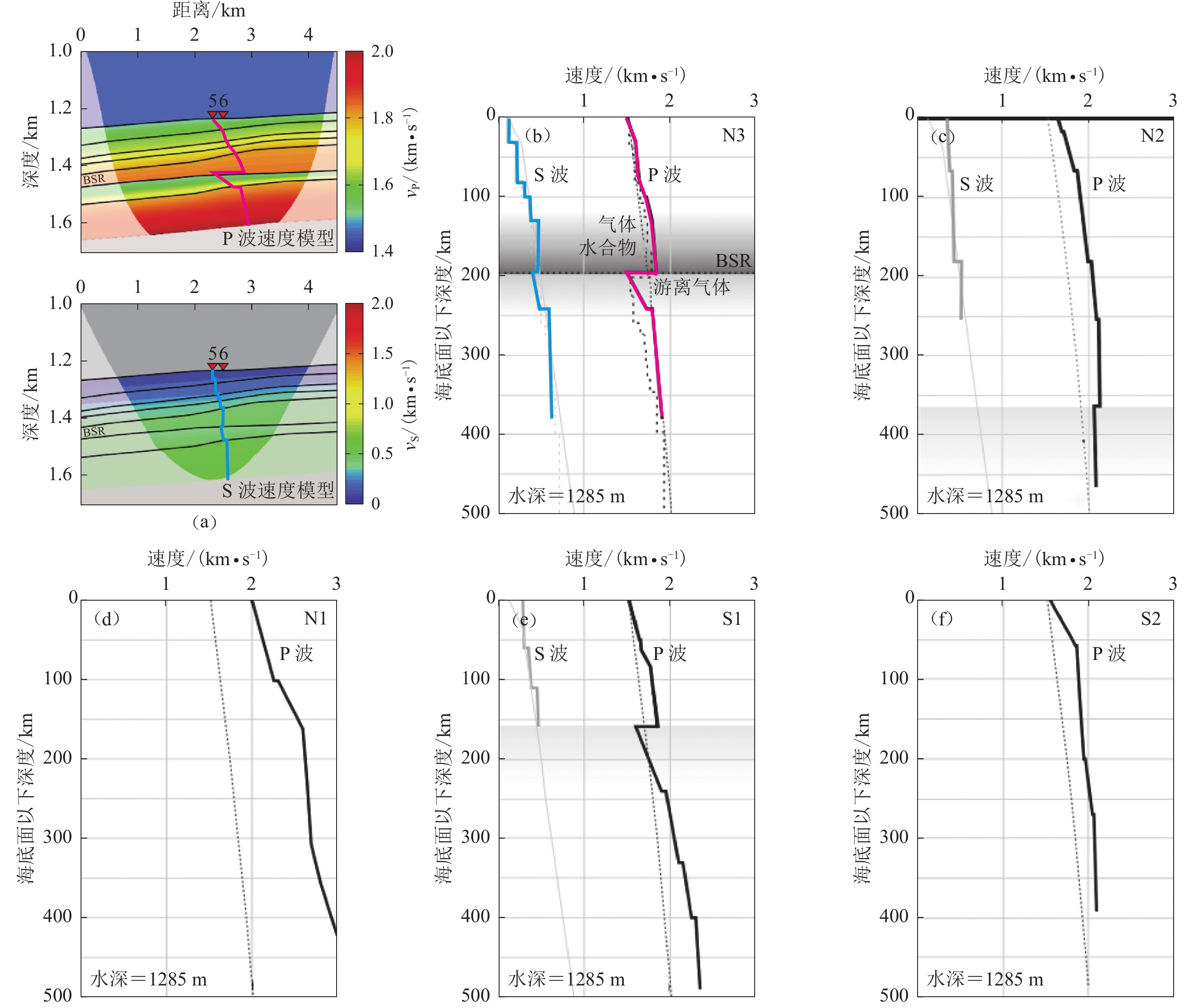
 下载:
下载:



